Know the Etymology: 195
Place Name of the Day: Wednesday, 16 March 2011
Azhignchil-poththaanai (Alinchipothana),
Unnichchaikku'lam
அழிஞ்சில்-பொத்தானை,
உன்னிச்சைக்குளம்
aḻiñcil-pottāṉai,
Uṉṉiccaikkuḷamazhinchil+poththaanai, unnichchai
The grassland or thicket of Alangium lamarckii trees
The tank of Alangium lamarckii trees or Lantana indica plants
| Azhignchil |
Also Azhignchu, A’nignchil: A tree; sage-leaved alangium, Alangium lamarckii (Tamil, Dravidian Etymological Dictionary 280); A source for herbal medicine (Kathiraiver Pillai); Azhigngnil: Alangium decapetalum (Malayalam, DED 280); Angkota, Angkola, Angkolla, Angkollaka: Alangium hexapetalum (Sanskrit); Ankola: Common name for the tree in north Indian languages;
|
| Unni |
Azhignchil (Tamil, Madras Tamil Lexicon, Vaiththiya Moolikai Virivakaraathi); also a plant, Lantana indica, a native species of Lantana bearing light purple flowers (Tamil, MTL); U’n’ni: Wart (Tamil, DED 3701); Pimple on the face of children (Malayalam, DED 3701); Tick on dogs, sheep, cattle etc (Tamil/ Malayalam DED 604); Unnich-chedi, Naay-unni: The common weed Lantana, gained the name perhaps because of its fruits looking like warts or ticks or because it is used in the treatment of tetanus (Tamil). Some of the species such as the Lantana camara was introduced in the colonial times.
|
| Poththaanai |
Also Paththanai: Grassland (Eezham Tamil); Puthal, Puthar: Grass, low jungle, bush (Tamil, DED 4509); Patana: Grassland, open land or thicket, especially covering small hills (Sinhala). Also see column on Poththuvil
|
| Ku'lam |
Tank, lake, reservoir (Tamil, DED 1828).
|
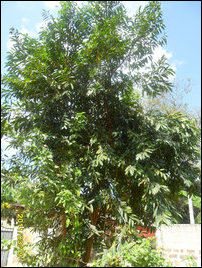
A young, Azhignchil/ A’nignchil tree (Alangium lamarchii) found at Thirunelveali in Jaffna. A matured tree that yielded fruits and found in the locality was felled down sometimes back.
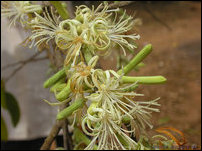
Azhignchil, Alangium salvifolium [synonym of Alangium lamarckii], flowers [Image courtesy: Lalithamba’s photostream 199, flickr.com]
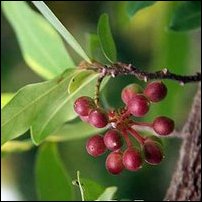
Azhignchil, Alangium lamackii, fruits [Image courtesy: tamilkurinji.com]
Azhignchil, Alangium lamarckii, is a small tree found in the dry and intermediate zones. Varieties of it such as Alangium hexapetalum are found in the wet zone too, up to 1200 m altitude. This tree having thorns is also called Mu’l-azhignchil.
The Tamil terms Azhignchil and A'nignchil for the tree and its Malayalam cognate Azhigngnil are listed as words of Dravidian etymology (DED 280).
An early description of the tree could be found in the c.10th century CE Tamil literature Cheevaka Chinthaama’ni:
“காசு இல் மட்டு ஒழுகப் பூத்த அழிஞ்சில் கண்ணார் கவின் கொண்டன” (சீவக சிந்தாமணி 7:93)
“Kaasu il maddu ozhukap pooththa azhignchil ka’n’naar kavin ko’ndana” (The Azhignchil tree in blossom, oozing with clean honey, was an eyeful beauty; Cheevaka Chinthaama’ni 7:93)
The tree is mostly called A’nignchil in Jaffna. It grows wild. Matured trees bear beautiful flowers and red fruits. The edible fruits taste like Rambutan and are a favourite of children.
The common name for the tree in North Indian languages is Ankola, which is a cognate of the Sanskrit names for the tree (see table). A derivative, Angkoalam, is also found used in Tamil medical texts.
Various parts of Azhignchil, such as leaves, bark, root, fruit and seeds are highly valued in traditional herbal preparations especially in the treatment of leprosy, wounds, skin diseases and bites of snakes, rat, dog etc.
Recent studies show that the pharmacological contents of the tree induce cell growth and serve as anti-microbial and anti-cancer agent.
Kathiraiver Pillai’s Tamil dictionary says that the tree is a Kiraa’ni-thiraviyam (a herb to treat stomach disorder).
Tamil medical texts speak of varieties of the tree bearing white, red and black flowers and the black-flowered tree is prescribed for certain esoteric preparations.
The oil extracted from the seeds is highly valued in skin treatments. The seed powder is put into gingelly oil and exposed in sunlight for 21 days to make the herbal oil by the tribes of Chhatisgargh in Central India, records Pankaj Oudhia (botanical.com).
A very interesting observation he has made is the use of the oil in the herbal treatment of plants by the tribes of Chhatisgargh. Solutions made from the oil are effective pesticides in treating horticultural crops and seeds of fruit trees such as mango, jackfruit etc, treated by dipping them in the oil germinate sturdily, he records.
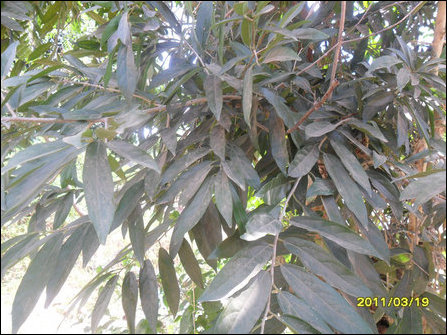
Foliage of a young Azhignchil/ A’nignchil (Alangium lamarchii) tree found at Thirunelveali in Jaffna
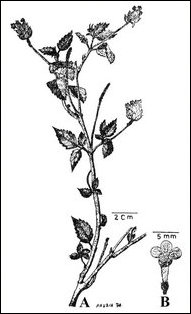
Unni, Lantana indica, a species native to the South Asia region [Image courtesy: Flora of Pakistan, efloras.org]
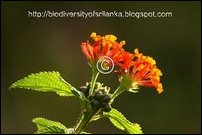
The weed, Lantana camara introduced into the island in the early 20th century and have become invasive today. All Lantana is commonly called Naay-unni in Eezham Tamil. [Image courtesy: biodiversityofsrilanka.blogspot.com]
The term Unnichcahi, coming from Unni, means the Azhignchil tree as well as a plant Lantana indica.
Weeds belonging to the lantana family are commonly found in the island. Many of them have come in the colonial times as ornamental plants and have become invasive today, destroying other natural vegetation, especially the grasslands. But, the wild shrub Unni or Lantana indica, bearing light purple flowers, is native to the region. It is found rarely.
A common term found used for plants of Latana family in Eezham Tamil is Naay-unni or Naay-u’n’ni. Perhaps the name has come because of its fruits looking like warts or ticks on a dog or because of the use of the plant in treating tetanus.
Besides tetanus, Unni was also used in the treatment of rheumatism and malaria.
* * * Poththaanai is a place name component commonly found especially in the East of the island, meaning an expanse of grassland or thicket. The term is etymologically related to Puthal or Puthar in Tamil/ Dravidian, meaning grass, bush, thicket, low jungle etc (DED 4509). The component also corresponds to Patana in Sinhala and Paththanai in Eezham Tamil. See column on
Poththuvil for further discussion.
* * * Azhignchil-poththaanai, commonly written in English in the Sinhalicised form,
Alinchi-pothana, is a place in Welikanda division of Polonnaruwa district.
Unnichchaik-ku'lam is in Ma’nmunai West (Vavu’na-theevu) division of Batticaloa district. The village
Unnichchai in this place got the name from the tank.
* * * Some related place names:
A’nignchiyan-ku’lam: The tank of A’nignchil or Azhignchil trees; Thu’nukkaay division, Mullaiththeevu district. Note the word formation A’nignchiyan having the ‘An’ suffix, which is a typical feature of the Eezham Tamil usage found in the place names.
Kal-poththaanai: The grassland/ thicket of rocks; Ea’raavoor-pattu division, Batticaloda district.
Nediya-poththaanai: The big grassland/ low jungle; Ea’raavoor-pattu division, Batticaloa district.
Poththaanai: The grassland/ low-jungle; Ea’raavoor-pattu division, Batticaloa district
Chamu’laiyadi-poththaanai: The grassland/ thicket in the locality of Chamu’lai (Chama’ndalai) trees; Ea’raavoor-pattu division, Batticaloa district
Mu’l’li-poththaanai: The grassland/ thicket of Mu’l’li plants; Thampalakaamam division, Trincomalee district
Pothana: The grassland/ thicket; Dambulla division, Matale district; Giribawa division, Kurunegala district; Mihinthale division, Anuradhapura district.
Horow-pothana: The grassland/ thicket of Horow trees; Horowpothana division, Anuradhapura district
Thikkam-pothana: The grassland/ thicket of Thikkam plant; Kahatagasdigiliya division, Anuradhapura district
Bandara-pothana: The grassland/ thicket of the prince or chief; Kekirawa division, Anuradhapura district
Welimuwa-pothana: The grassland/ low-jungle of white-faced monkeys; Horowpothana division, Anuradhapura district. Wælimuwa: The white-faced monkey (Sinhala). The name Wæli-muva in Sinhala for the white-faced monkey is an interesting evidence to understand that the word Wæli in Sinhala that commonly means sand, originated from Tamil/ Dravidian etymology. Vaal in Tamil, corresponding to Paal originally means white, whitish etc., and as a derivative, Vaalukam in old Tamil means white sand as found in the seashore, sand dunes etc (Dravidian Etymological Dictionary 5364). Wæli-muva: Wæli here means white and Muva, corresponding to Tamil/ Dravidian Mukam (DED 4889) means face.
Pali-pothana: Probably, Pa’l’li-pothana, the grassland/ thicket of a pastural settlement; Kahathagasdigiliya division, Anuradhapura district
Dekethi-pothana: The second grassland/ thicket; Horowpothana division, Anuradhapura district
Also see column on
Poththuvil for other examples.
First published: Wednesday, 16 March 2011, 01:37
Previous columns:












